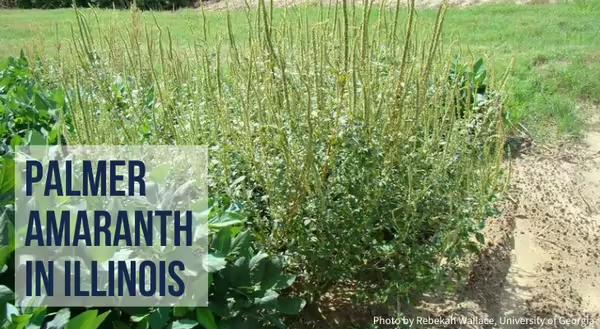
Palmer amaranth is an invasive weed species we have been hearing a lot about in agriculture over the last 10 years, and it continues to be a threat after its first documented appearance in Illinois in 2012. Native to southwestern US states, palmer amaranth has made its way to 39 of the states.
Palmer amaranth is one of several Amaranthus species in Illinois; it is a fast-growing annual weed growing up to 3 inches per day reaching an overall height around 6 ft. The plant can produce up to 100,000 to 500,000 seeds, and the seeds can remain dormant in the soil for many years.
With a quick glance, most of the plants in the amaranth family look similar, but Palmer amaranth(PA) and waterhemp(WH) tend to be very difficult to differentiate. Unlike redroot pigweed and smooth pigweed, PA and WH have hairless (glabrous) stems. WH tends to have long and narrow leaves compared to PA’s wider, ovate to diamond shape. The leaf petioles of PA are commonly longer that the leaf blade. A silver watermark can sometimes be found on the leaves of PA plants; however, this can also occasionally be found on WH leaves.
Distinguishing between PA and WH is much easier when the plants have started flowering. Both species are dioecious meaning separate male and female plants. Female plants can be identified by rubbing the inflorescence and looking for small black seed. PA inflorescences can be up to 1” in diameter with terminal branches reaching up to 3 feet long which is much larger than WH; however, male WH plants can also have thick inflorescences which can be confused as PA. A more distinguishing feature of PA is the large bract on the female flowers; as these mature, they make the seed head painful to grab. You will also find this with redroot pigweed and smooth pigweed; however, we know these species are monecious with hairy stems making it easier to distinguish.
Research has shown that Palmer amaranth has a high germination percentage at both high and low temperatures with multiple emergence events throughout the growing season. With it’s highly adaptive and competitive ability, it is essential to be proactive and take measures to prevent Palmer amaranth from spreading. Below are some recommendations for effective control of Palmer Amaranth:
- Scout. It is important to scout and be able to properly identify Palmer amaranth to make the proper control measures. Begin scouting 14 to 21 days after crop emergence. You should also check fence lines, roadsides, and non-crop areas. We often see weed infestations start off in non-crop areas.
- Start with a clean field. Use a burndown of something other than glyphosate. Palmer amaranth can easily develop resistance to herbicides, so it is important to use alternative herbicides (e.g. 2,4-D; Liberty, etc.) in burndown applications for no-till fields. In tilled fields, make sure established weeds are killed.
- Timely postemergence applications. Timing is everything. Herbicide applications must be applied before plants are 3 to 4 inches. Because Palmer amaranth can grow up to 3” per day, application timing is so important. Applying postemergence herbicides too late is probably the number one cause of control failures of this weed.
- Include residual herbicides with postemergence applications. Consider including a soil residual herbicide with a foliar applied herbicide to control the prolonged emergence pattern of Palmer amaranth.
- Use a diversity of herbicide groups. Using a single herbicide program will result in new herbicide resistant biotypes. It is best to use multiple herbicide groups that are effective against pigweed species and rotate groups over time.
- Use cultural and mechanical practices. Consider using other practices such as planting date, row spacing, plant population, etc. to enhance the competitiveness of the crop. If you have a field with weed infestations, harvest it last to prevent seed spread to other fields. Physically remove any escape plants before they reach the reproductive stage. Plants should be cut off at or below the soil surface and removed from the field
By using these preventative methods, we can work to minimize the impact the Palmer amaranth has on corn and soybean production.
Learn more about Illinois invasive species.
Sources and more information.
- Hager, A. 2014, Management of Palmer amaranth in Illinois. http://bulletin.ipm.illinois.edu/wp-content/uploads/2014/05/Palmer-Amaranth-2014-HI.pdf
- Hartzler, B. Palmer amaranth: ID, biology and managment. https://crops.extension.iastate.edu/encyclopedia/palmer-amaranth-id-biology-and-management